What packing supplies should you use?
Packing supplies affect every part of your move. In Miami, the weather brings moisture, heat, and sudden rain. As a result, weak boxes break and cheap tape fails. Without the right materials, items get damaged, and time gets wasted. So, stop wondering, “What packing supplies should you use”? With smart tools and this Pro Movers Miami guide, your move stays safe, organized, and on schedule.
Why packing supplies matter for a move in Miami
Moves often go wrong because people pick the wrong materials. In Miami, this mistake carries extra risk. The heat weakens adhesives, humidity ruins cardboard, and sudden rain soaks furniture before it reaches the truck. Boxes collapse, items shift, and small parts go missing without it.
Every part of your move depends on strong, reliable packing. So, before you commit to professional assistance, there are essential things to know before hiring packers. The right setup and assistance avoid last-minute stress and keep damage under control.
Necessary packing tools and materials
Before you pack, gather the basic tools. These help you measure, seal, cut, and label with accuracy. Skipping even one of them creates delays and slows down your movers. Packing tools you need are:
- Tape dispenser for quick and even sealing
- Permanent markers for clear labeling
- Box cutter or a utility knife for safe opening
- Scissors for cutting plastic wrap or tape
- Color-coded labels or stickers for each room
- Zip ties for cable bundles and loose items
- Stretch wrap roller for furniture or awkward shapes
- Moving dolly to carry heavier boxes faster
Once the tools are ready, focus on the materials that protect what you pack. Each item has a specific role; missing one of these often leads to breakage or wasted space:
- Small, medium, and large cardboard boxes
- Specialty boxes for TVs, dishes, or wardrobes
- Heavy-duty packing tape
- Bubble wrap for fragile surfaces
- Packing paper for scratch prevention
- Foam sheets for electronics or glass panels
- Packing peanuts to fill loose space
- Mattress covers to block dirt and moisture
- Stretch plastic wrap for large furniture
- Ziploc bags for screws, cords, or small hardware
- Trash bags or vacuum bags for clothes and bedding
- Plastic bins for reusable, sealed storage
Each item on these lists supports a smoother, safer move. When selected carefully, supplies reduce repacking, speed up unloading, and keep your things in good condition, even if the weather shifts suddenly. Miami’s climate demands more than a few old boxes and tape rolls. Use the right materials and packing services in Miami, and your move becomes less chaotic and more predictable.
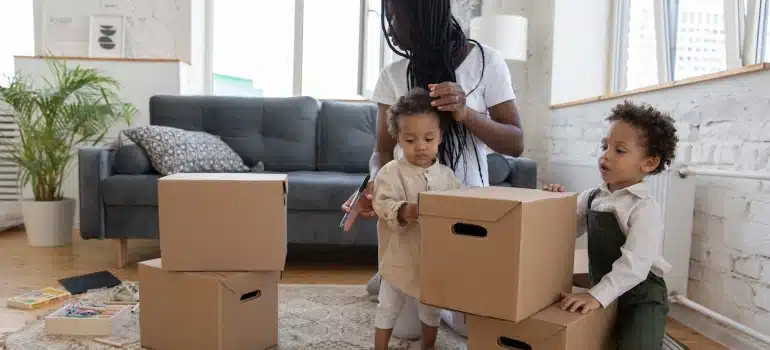
Choosing the right boxes for different items
Every move starts with boxes, but not every box fits every item. Size and strength matter more than appearance. In Miami, humidity can weaken cardboard quickly, especially if it’s thin or reused. That’s why picking the right box for each category of belongings helps prevent crushing, tearing, and wasted space.
Boxes come in different shapes and weight limits. Larger doesn’t always mean better. A big box filled with books becomes too heavy to lift. A small box packed with pillows wastes space. Match box size to item weight and density to keep things balanced. Types of boxes you should use:
- Small boxes (16″ x 12″ x 12″ – up to 65 lbs): Best for books, canned food, tools, and small electronics
- Medium boxes (18″ x 16″ x 18″ – up to 65 lbs): Ideal for kitchen items, clothes, decor, and pantry goods
- Large boxes (24″ x 18″ x 18″ – up to 50 lbs): Use for light but bulky items like linens, bedding, and lampshades
- Dish packs (18″ x 18″ x 28″ – up to 80 lbs): Reinforced for fragile dishes and glassware
- Wardrobe boxes (24″ x 24″ x 40″ – up to 100 lbs): Come with hanging rods to move clothes wrinkle-free
- TV boxes (sizes vary by screen size – 50 to 100 lbs): Protect flat screens and monitors during transport
- File boxes (15″ x 12″ x 10″ – up to 40 lbs): Keep documents upright and organized
Heavy items need strong walls and tight packing. Light items need space without movement. In each case, use tape along the seams and reinforce the bottom with an extra strip. In Miami’s climate, fresh materials offer the safest route. So, opt for reliable moving boxes in Miami and avoid old or used grocery boxes, as moisture damage and pests often go unnoticed until it’s too late.
Bubble wrap
Bubble wrap protects fragile items by absorbing impact during movement or sudden drops. Its cushioning effect makes it useful for dishes, electronics, and decor with delicate edges. Because it’s flexible and lightweight, it wraps around uneven shapes without adding too much bulk. Movers and homeowners often use it to fill gaps or create buffer zones between items inside a box.
Types of bubble wrap
Bubble wrap comes in a few versions:
- Small bubble (3/16″): Ideal for glasses, vases, or picture frames
- Large bubble (1/2″): Best for heavier or oversized items like lamps and monitors
- Anti-static: Prevents static buildup when packing electronics
Each serves a different need depending on the size and sensitivity of your items.
Price range and availability
Prices range from $18 to $30 per 175-foot roll. Standard rolls are 12–24 inches wide. You can buy them from local stores like Home Depot or online through moving supply sites. Some stores in Miami also carry contractor-grade rolls for bulk packing.
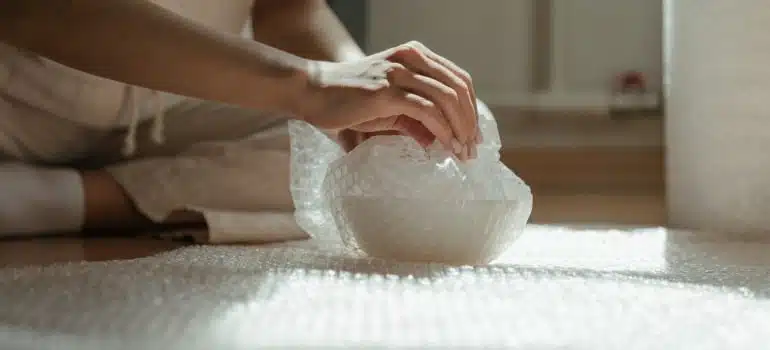
Eco-friendly alternatives to bubble wrap and recycling
Eco-conscious options include biodegradable bubble wrap made from recycled plastic or compostable starch-based films. Reusable air pillows are another option, they’re flat until inflated, which saves space during storage. Bubble wrap isn’t accepted in curbside bins, but drop-off recycling is available at major retailers like Target, Publix, or Best Buy across many cities, including Miami.
Pros and cons of bubble wrap
Bubble wrap offers strong protection without much weight. It’s especially effective for absorbing shock during long-distance moves or rough handling. However, it takes up space, doesn’t break down easily in landfills, and often requires additional disposal steps.
In humid areas, over-wrapping with bubble wrap may trap moisture around items, which can affect wood, books, or electronics. To reduce avoidable damage, it helps to review a few common packing mistakes before sealing your boxes. Still, if you wonder what packing supplies should you use for fragile surfaces or odd shapes, it remains one of the most reliable materials available.
Packing paper
Packing paper is clean, flexible, and safe for nearly all household items. It’s commonly used to wrap dishes, mugs, silverware, and pantry goods. Unlike a newspaper, it doesn’t bleed ink, which prevents smudging and surface stains. Its low cost and recyclability make it a staple in both professional and DIY moves.
Types of packing paper
There are a few variations of packing paper:
- White newsprint: Thin, ink-free paper for glassware and kitchen items
- Kraft paper: Thicker and more durable, suitable for stacking and layering
- Tissue paper: Best for wrapping polished, sensitive, or collectible items
Some are better for light layering, while others provide structure inside boxes.
Price range and availability of packing paper
A 25-lb bundle typically costs between $25 and $35. Packs are available in hardware stores, moving supply centers, and online through U-Haul or Amazon. Local suppliers often offer multi-size bundles for small to large moves.
Eco-friendly alternatives to packing paper and recycling
All three paper types are recyclable, as long as they’re not soiled with tape or food. Curbside recycling programs in Miami and most major U.S. cities accept clean packing paper. If you want to reduce waste further, save sheets for future moves or use them for seasonal storage. Kraft and newsprint also break down easily in compost systems.
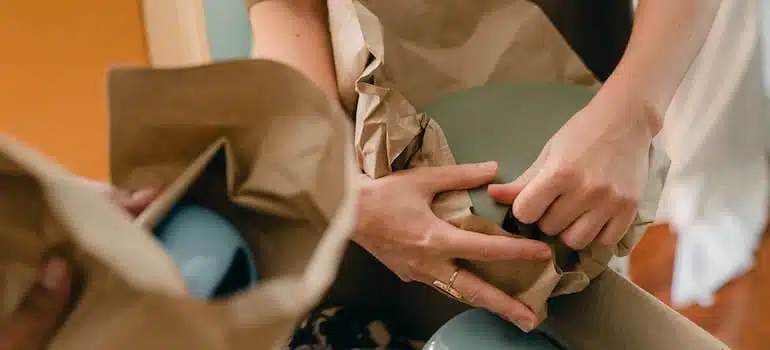
Pros and cons of packing paper
Packing paper is lightweight, stackable, and easy to mold around fragile objects. It prevents surface scratches and keeps items from shifting inside boxes. The downside is that it doesn’t offer much impact protection, so you often need multiple sheets for fragile items. It’s also less effective against moisture or pressure, so it’s best used alongside more protective materials when packing glass or electronics.
Foam sheets
Not sure what packing supplies you should use for fragile items? Foam sheets protect flat, fragile, or polished items by creating a soft, even barrier. They prevent surface scratches and absorb pressure between layers. High-value items often require both foam padding and white glove packing to reduce risk during transport.
In Miami, foam sheets work well because they resist moisture better than paper and don’t compress like bubble wrap under heat. They’re also less bulky, which helps save space inside boxes or bins. Movers often use them to separate dishes, TV screens, glass tops, mirrors, and framed prints.
Types of foam sheets
Foam sheets come in several thicknesses and styles, depending on how much padding you need:
- Thin foam sheets (1/16″): Used between stacked plates, trays, or picture frames
- Medium foam sheets (1/8″): Suitable for electronics, lamps, and mirrors
- Perforated foam rolls: Easier to tear and ideal for wrapping or lining box interiors
- Adhesive-backed foam: Used for custom-fit protection, often in high-value item shipping
Price range and availability of foam sheets
Foam sheets cost between $15 and $35, depending on thickness and quantity. Packs often include 50 to 100 sheets measuring 12″ x 12″ or 12″ x 24″. Perforated rolls cost more but offer greater flexibility. They’re available at office supply stores, Uline, U-Haul, and many online moving supply shops. In Miami, specialty hardware retailers and warehouse clubs may carry contractor-grade packs in bulk.
Eco-friendly alternatives and recycling for foam sheets
Most polyethylene foam sheets are not curbside recyclable and should be reused if clean. Some cities have foam recycling drop-offs, but availability is limited. In Miami-Dade County, standard foam recycling is not widely available.
As an alternative, some companies offer green cell foam, a biodegradable sheet material made from cornstarch, which dissolves in water and leaves no residue. Recycled paperboard layers or fabric wraps are also used as foam substitutes for more eco-conscious moves.
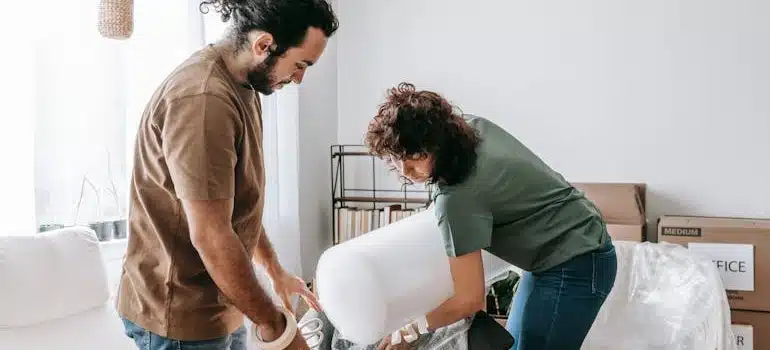
Pros and cons of foam sheets
Foam sheets provide excellent surface protection without adding weight or bulk. They work especially well in humid climates, as they resist water better than paper and don’t stick to smooth surfaces like bubble wrap can. The flat structure also makes stacking and organizing easier inside boxes.
On the downside, foam sheets offer less shock absorption than bubble wrap and aren’t as widely recyclable. For heavy or high-risk items, foam alone may not be enough and should be used alongside other padding materials.
Packing peanuts
What packing supplies should you use to fill space inside boxes? Packing peanuts prevent items from shifting during transit. Their main function is gap control, useful when packing irregular shapes or combining multiple wrapped items in one container.
Unlike foam sheets or paper, peanuts support items from all sides, making them useful for fragile pieces packed in larger boxes. In humid regions like Miami, standard peanuts stay stable, but they can generate static or create a mess if overused.
Types of packing peanuts
There are two main types, each with different handling and disposal properties:
- Polystyrene (plastic): Traditional white peanuts, lightweight and reusable
- Starch-based (biodegradable): Made from cornstarch, water-soluble, and safe for the environment
Some newer options are anti-static, which makes them safer for packing electronics. You’ll also find color-coded peanuts; green often indicates recycled content, while pink signals anti-static.
Price range and availability of packing peanuts
Packing peanuts cost between $15 and $25 for a 3.5-cubic-foot bag. Smaller packs are available at shipping stores or big-box retailers. Large-volume users often buy directly from packaging suppliers. In Miami, you can find them at The UPS Store, U-Haul, and specialty shipping supply shops.
Eco-friendly alternatives and recycling for packing peanuts
Biodegradable packing peanuts dissolve in water and leave no toxic residue, making them ideal for environmentally conscious moves. These are commonly sold online and in office supply stores. Traditional polystyrene peanuts are not accepted in curbside bins and must be taken to designated drop-off locations. Some Miami-area shipping stores will accept clean peanuts for reuse. Always call ahead to confirm.
Pros and cons of packing peanuts
Packing peanuts fill gaps effectively and support multiple items in the same box without pressure points. They’re lightweight and flexible, which reduces shipping weight. However, they can be messy and hard to control when unpacking.
Plastic peanuts are also non-biodegradable and can pose disposal issues if local recycling options are limited. Starch-based versions solve this problem, though they’re slightly more expensive and less durable in high-humidity storage.
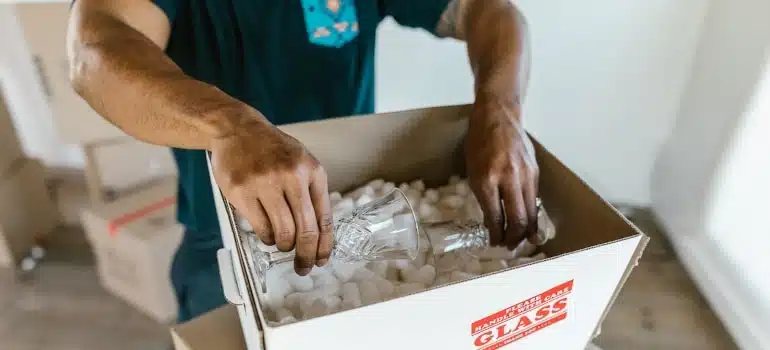
Furniture pads
Furniture pads, also known as moving blankets, are packing supplies that protect large items like dressers, headboards, dining tables, and appliances. They prevent surface scratches, edge dents, and friction during loading or transit. Movers rely on them for wood, metal, and glass pieces that are too large to box. In Miami, where short-distance moves often involve navigating elevators or tight stairwells, furniture pads reduce the risk of scrapes from walls or door frames.
Types of furniture pads
There are different grades of furniture pads based on material and durability:
- Light-duty pads: Made of recycled synthetic fibers, used for light protection
- Heavy-duty quilted pads: Provide thick coverage and can be reused many times
- Non-woven pads: Cheaper and single-use, often included in rental truck kits
Price range and availability of furniture pads
Rental pads cost $10–$15 per dozen for one-day use from U-Haul or Penske. Buying new ones ranges from $7 to $15 per pad depending on thickness and quality. Miami-area moving supply stores and tool rental centers often carry heavy-duty pads in bulk.
Eco-friendly alternatives and recycling for furniture pads
Reusable quilted pads are considered eco-friendly due to their long lifespan. If lightly worn, they can be donated or reused indefinitely. Worn-out synthetic pads are not curbside recyclable but can sometimes be accepted at textile recycling centers. DIY movers may also repurpose old blankets or comforters for short local moves.
Pros and cons of furniture pads
Furniture pads provide excellent surface protection, especially for bulky or heavy items. They reduce direct contact between pieces and help prevent scratches, dings, and chips. They also work well in trucks with limited space, where furniture may shift. However, they take up storage space and can be expensive to purchase for one-time use. Light-duty pads also offer limited padding compared to quilted versions.
Stretch plastic wrap
Stretch plastic wrap holds items in place and creates a tight barrier that blocks dirt and dust. In humid areas like Miami, it’s commonly used to seal furniture after applying padding or foam. Local movers in Florida use it to secure drawers, bind sofa cushions, or wrap together disassembled furniture parts. It sticks to itself but not to surfaces, making it safer for delicate materials than tape.
Types of stretch plastic wrap
Wrap types differ mainly by width and thickness:
- 5-inch rolls: Handy for bundling chair legs or cords
- 15–20-inch rolls: Used to wrap furniture and large boxes
- High-gauge wrap: Thicker and stronger, designed for heavy items or sharp edges
Price range and availability of stretch plastic wrap
Smaller rolls start at $6–$10, while larger ones cost $20–$35. Stretch wrap is widely available at home improvement stores, moving centers, and online suppliers. When searching for what packing supplies you should use in Miami, most hardware chains and storage facilities carry multi-pack rolls for residential use.
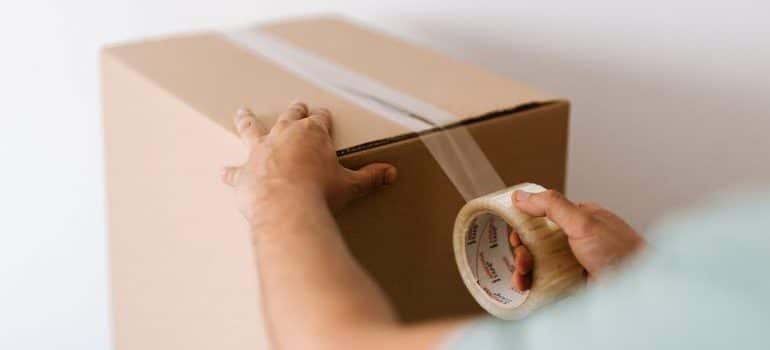
Eco-friendly alternatives and recycling for stretch plastic wrap
Standard wrap is made of polyethylene and is not accepted in curbside bins. However, it can be dropped off at plastic film recycling sites (e.g., Target or Publix). Some companies offer recyclable stretch film made with lower-impact materials, though availability is limited. Reusing partially used rolls is common in local moves.
Pros and cons of stretch plastic wrap
Stretch wrap is versatile, easy to apply, and prevents shifting without damaging surfaces. It helps keep items clean and secure during transport. Unlike tape, it doesn’t leave residue or peel finishes. On the downside, it’s single-use, not biodegradable, and can trap heat or condensation if used in excess. For best results, combine it with fabric padding or foam on moisture-sensitive furniture.
Mattress covers
Mattress covers protect beds from dirt, moisture, bugs, and scratches during a move. In Miami, where high humidity and frequent rain can soak exposed furniture, they help avoid mold or staining. Mattress covers are essential for storage in Miami or long-distance moves, but are also useful in short hauls where beds may brush against walls or floors.
Types of mattress covers
When choosing what packing supplies you should use for mattresses, the covers do not have a safer alternative. And yet, cover styles vary based on protection level and fit:
- Plastic slipcovers: Basic, disposable options that slide over like a bag
- Zippered covers: Offer full enclosure and better sealing
- Fabric covers: Reusable and breathable, often used for storage
Standard sizes include twin, full, queen, and king. Always match the cover to the exact mattress type to avoid gaps.
Price range and availability of mattress covers
Plastic covers start at $10–$15 each. Zippered versions cost $20–$35. You can find them at mattress stores, moving supply retailers, and national chains like Walmart or Lowe’s. In South Florida, many U-Haul and self-storage outlets stock both disposable and reusable options.

Eco-friendly alternatives and recycling for mattress covers
Reusable fabric covers reduce waste and often last through several moves. Plastic covers are not curbside recyclable but can sometimes be repurposed as drop cloths. Miami-Dade County does not accept these in standard recycling bins. To avoid waste, store your cover and reuse it for future moves or under-bed storage.
Pros and cons of mattress covers
Mattress covers block dirt, liquids, and debris effectively. Zippered models seal better and provide peace of mind when storing beds long-term. Plastic versions are cheap and quick to apply, but they tear easily and don’t breathe well. In hot, humid conditions, this can trap moisture inside the cover if left sealed for too long. Breathable fabric covers solve this problem, but cost more and take up extra space when not in use.
Get the right supplies, pack with less risk
Packing supplies is never a waste of time and money. Each item has a specific role in protecting your belongings. In a city like Miami, where heat, humidity, and tight spaces affect every move, the right materials make a real difference. They prevent delays, reduce breakage, and help you unpack without stress.
Start with strong boxes and the tools that make packing faster. Add protective materials based on what you’re moving and how far. Some items need cushioning, others need moisture barriers or tight wrapping. The more care you take with supplies, the fewer problems you’ll face on moving day.
If you’re packing for your Miami move on a deadline, it becomes even more important to know what packing supplies you should use to avoid last-minute problems. Therefore, working with local residential movers in Miami who provide high-quality materials can help. Whether you pack yourself or hire help, good supplies are always worth it!
